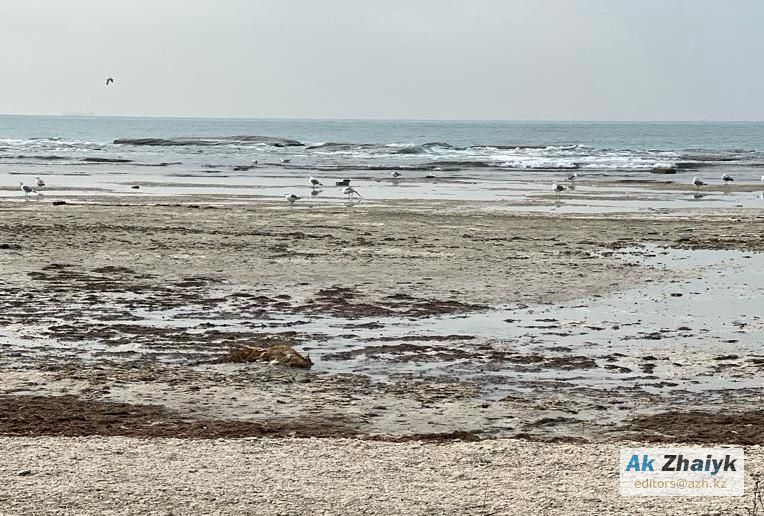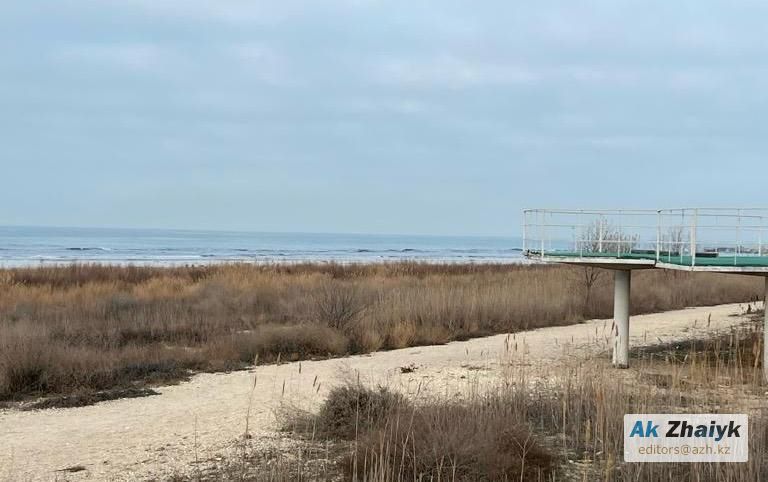The shallowing of the Caspian Sea is becoming one of the most serious environmental problems affecting not only Kazakhstan, but also other Caspian states. Every year the water goes farther and farther, exposing the area of the seabed. According to the Institute of Hydrobiology and Ecology of Kazakhstan, the sea level is decreasing by 25 centimeters per year and since 2000 the depth of the reservoir has decreased by 2 meters, writes the Information Bureau.

Russian scientists report that over the past 18 years, the surface area of the sea has decreased by 22 thousand square kilometers (which is equal to the area of Israel and Slovenia), half of which falls on the territory of Kazakhstan. They showed that the water level in the Caspian Sea is falling at a rate of 69 centimeters per year.
Only last year, it was noted that over the past 15 years, the water area of the Kazakh sector of the Caspian Sea has decreased by 7.1%. Vast areas of shallowing of the sea are observed in the Kazakh part near the city of Atyrau.
Why the Caspian Sea is retreating
The constant reduction of water basins is considered primarily a consequence of global warming and active human economic activity in coastal regions.
Asel Tasmagambetova, an ecologist and founder of the Central Asian Institute for Environmental Research (CAIER), emphasizes that large oil companies engaged in dredging also contribute to the deterioration of the environmental situation.
“Transgression (the advance of the sea on land) and regression (retreat of the sea from the shores) of the Caspian Sea occur every hundred years, which is its natural feature. However, according to the calculations of German scientists, the current retreat of the sea will continue at least until 2054,” she notes.
Azamat Kauazov, coordinator of the Central Asian Climate Information Portal (CACIP), highlights another problem – the reduction in the flow of rivers that feed the Caspian Sea. The main contribution to the water resources of the sea (about 80%) is made by the Volga, but its flow has significantly decreased in recent years. A similar situation is in the Urals, which is also experiencing a water shortage.
“The tipping point was reached last year when sea levels dropped to near historic lows. But this year there has been a temporary improvement. Thanks to the spring floods, the water rose by a meter or even more in the northern part of the sea,” Kauazov said.
However, it is too early to rejoice, researchers say. According to climatologists, the region will face serious difficulties in the future. Computer models show that rainfall throughout the region, including the Caspian Sea basin and Central Asia, will decrease, Azamat Kauazov added. At the same time, an increase in temperature will increase evaporation, which will lead to even greater water losses. The expert warned that annual changes may seem insignificant, but the cumulative effect can be devastating.
Threats to the life of marine life
At present, environmentalists are especially concerned about the deterioration of the environmental situation in the Caspian Sea. They note that lowering water levels and decreasing water surface area alter salinity and pose a threat to many species of flora and fauna. As a result of this factor, biodiversity and fish numbers are decreasing. In addition, as the volume of water decreases, the concentration of pollutants increases. Changes in the ecosystem can also trigger the migration of species, disrupting food chains and increasing competition.

Assel Tasmagambetova emphasizes that the massive decline in the Caspian seal population is an alarming signal for the five Caspian states.
“The Caspian seal is endemic (a species of living organisms that is found only in a certain geographical area and nowhere else), and its health is considered an indicator of the ecological well-being of the entire Caspian Sea. Changes in the ecosystem can lead to the fact that seals will be forced to look for new, safer places to rest and breed,” the ecologist explains.
According to her, environmental changes can also impoverish their food base, consisting of sprat and herring. All these factors pose serious threats to the life of seals and reduce their population.
“In recent years, we have observed several cases of mass seal mortality on the coast of several Caspian states, including Kazakhstan. During the last mass death of the Caspian seal, it was found that most of the dead animals were pregnant females,” Assel Tasmagambetova shared the results of the study.
The main patients of the Central Asian Institute of Environmental Research are seal pups under the age of three months, separated from their mother early. Seal pups have wounds from fishing nets, high fever, viral and infectious diseases.
“We felt the consequences of the mass death of seals and the deterioration of the environmental situation almost immediately. For two years, not a single live seal requiring veterinary care has been admitted to the Center for the Study and Rehabilitation of the Caspian Seal. We received messages from fishermen and local residents only about where they found dead animals,” the interlocutor said.
Assel Tasmagambetova stressed that by-catches and trade in products made from seal skin, fat, and meat are key problems in the region. During the pandemic, the researchers of the center learned that seal oil is in high demand in Aktau, which is recommended as a “miracle” medicine.
“We were horrified that this is happening in the XXI century. Having bought the entire range of seal oil offered, the institute’s laboratory examined the samples and revealed an increased concentration of heavy metals in the fat – cadmium, lead, arsenic,” says the ecologist.
Experts attribute the increased content of harmful substances to the activities of oil and gas companies on the Caspian shelf and emissions of sending substances into the sea. Seal fat entering the Kazakh markets is made in artisanal conditions, respectively, this makes it impossible to produce raw materials completely purified from harmful substances, the ecologist warns.
Assel Tasmagambetova notes that the successful restoration of the population is possible only if society consciously and carefully treats nature and wildlife. According to the ecologist, it is necessary to unite the efforts of all five Caspian states to create a unified system for registering endemics and improve the interstate program for the protection of the Caspian Sea. Such an approach will not only protect the Caspian seal, but also preserve the unique flora and fauna of this region, she said.
Shallowing of the Caspian Sea and water supply to Aktau
The decline in the level of the Caspian Sea is having an increasingly noticeable negative impact on the population, exacerbating the already difficult situation with the provision of drinking water to the region. According to Azamat Kauazov, the city’s water treatment and supply systems are designed taking into account a certain level of water in the sea and any decrease in it requires additional measures.
“Shallowing, unfortunately, will exacerbate the problem of water supply, as the region is developing, the population is growing, and water consumption is increasing. Therefore, simultaneously with the fall in the water level in the Caspian Sea, the problem will only worsen,” the specialist believes.
For example, dredging has already begun in Ashgabat to ensure the smooth operation of desalination plants, Kauazov said. Such measures may become in demand in Aktau, but will require significant financial investments, the volume of which is still difficult to estimate.
It should be noted that in Aktau, the problem of water supply has been especially acute for more than one year. There are several reasons for this: worn-out networks, frequent pipe breaks and interruptions in water supply. Despite the launch of new projects, Aktau residents continue to face long water outages, especially in the summer.
The situation becomes more complicated along with rising temperatures, when the infrastructure is working at its limits. Azamat Kauazov explains that high temperatures have a negative impact on the city.
“Firstly, overheating of equipment leads to an increase in the load on pumps, cleaning and cooling systems. Because of this, the infrastructure is under constant pressure. Secondly, in the hot months, the need for water increases: the population begins to use more resources, the demand from agriculture and industry increases. As a result, water supply and desalination systems are seriously overloaded,” says the hydrologist.
It is also critically important that water quality deteriorates as temperatures rise. Increased stress on filtration systems and changes in the concentration of substances can lead to water becoming more expensive and its quality worse. This, in turn, will have a negative impact on people’s health and the general standard of living in the region.
“High temperatures increase the risk of accidents of the equipment used. For example, last year the productivity of water treatment plants had to be reduced in order to avoid technological failures. This is especially critical in the arid climate of Aktau, where there are very few alternative water sources. Each accident can have serious consequences, so the problem must be solved immediately,” Kauazov said.
What is realistic to do right now
To adapt to climate change, the region needs to take a number of measures aimed at reducing dependence and vulnerability. As the expert explained, it will not be possible to completely eliminate the problem, but the introduction of a number of measures will help cope with extreme weather conditions.
“In many countries with a similar climate, similar problems are successfully solved. For example, the UAE, Israel, Australia and Saudi Arabia are states with high temperatures and arid conditions that have successful examples of adaptation,” the hydrologist said.
For example, solar desalination plants in Dubai and Saudi Arabia, efficient water use in Israel, which is considered a world leader in this field. In this country, methods of water conservation, drip irrigation and water recycling systems are actively used.
“In the conditions of Aktau, it is important to pay attention to the modernization of cooling and water supply systems. A significant part of the local infrastructure was built in Soviet times and has not been updated over the past decades, which makes modernization especially relevant,” Azamat Kauazov said.
Experts include the introduction of new reverse osmosis technologies that require less energy and are more efficient at high temperatures, the hydrologist explains. The use of renewable energy sources to power desalination plants is also relevant. In regions with high solar insolation, these solutions are especially useful, the interlocutor is sure.
“It is time for the region to look for and use alternative energy sources, introduce water-saving technologies, build reservoirs, and take organizational measures for effective management of water supply,” Kauazov said.
Nevertheless, according to forecasts, in the long term, the level of the Caspian Sea may decrease by 2-10 meters. With such a fall, adaptation measures may be insufficient.
“Adaptation measures will help only in the coming years. However, in the future, the problem may become much more acute and new solutions will need to be developed. Perhaps we will face the phenomenon of climate migration. According to UN estimates, more than 100 million people could become climate refugees, and Kazakhstan, including Aktau, will not be an exception, given its location in the arid zone,” the expert suggested.
https://azh.kz/ru/news/view/106867
